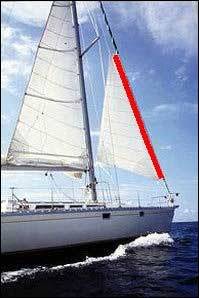When the tempestuous fury of nature unleashes its might upon sailors, the significance of well-designed storm sails becomes paramount. specialized sails engineered to withstand the harshest conditions, play a pivotal role in ensuring the safety and maneuverability of a sailing vessel during adverse weather. In this comprehensive guide, we delve into the world of exploring their purpose, construction, deployment, and how they contribute to the safety of sailors when facing the wrath of a storm.
The Purpose and Importance of Storm Sails: At the heart of the storm, winds howl with a ferocity that can overpower even the most resilient of regular sails. The designed to handle extreme conditions, offer sailors a lifeline when navigating through turbulent waters. Their primary objective is to reduce the force exerted on the vessel, allowing sailors to regain control and maintain stability.
Construction and Design: they are crafted with meticulous attention to detail, using durable materials that can withstand the strain of gale-force winds. Heavy-duty fabrics such as Dacron or high-strength synthetic fibers are common choices due to their durability and resistance to tearing. Reinforced stitching techniques ensure that the sails can endure the immense pressure exerted by the wind. The shape and size of sails also differ from regular sails, as they are intentionally smaller to minimize exposure to the wind’s force.
Key Features of Storm:
- Heavy Reinforcement: Reinforced corners and edges are a hallmark of The Sail. These reinforcements distribute the wind’s pressure evenly across the sail, preventing concentrated stress points that could lead to tears or damage.
- Adjustability: Storm sails are designed to be easily reefed or furled. This adjustability allows sailors to fine-tune the sail area based on the intensity of the storm. In extremely severe conditions, a storm jib alone might be sufficient, while in milder storms, a storm trysail could be utilized.
- High Visibility: Many incorporate bright colors or reflective elements to enhance visibility, aiding in communication with rescuers or other vessels during low-visibility conditions.
Deployment and Usage: Deploying demands skill, preparation, and swift execution. As the first squalls approach, sailors should anticipate the need for have them prepared for quick hoisting. Ensuring that all crew members are aware of the storm sail deployment plan is crucial, as a coordinated effort enhances safety.
Tips for Effective Storm Sail Deployment:
- Anticipation: Keep a vigilant eye on weather forecasts and the sky. Be prepared to switch to storm well before the storm strikes.
- Practice: Regularly practice deploying storm sails in calmer conditions. Familiarity with the process will be invaluable when facing an actual storm.
- Communication: Establish clear communication protocols among the crew. Everyone should know their designated tasks during storm sail deployment.
- Securing: Double-check that all lines, halyards, and fittings are properly secured. Loose lines can lead to chaotic situations when dealing with storm sails.
Enhancing Safety through Storm Sails: The utilization of goes beyond surviving a storm; it’s about minimizing risks and maximizing control. By employing sailors significantly reduce the likelihood of capsizing, broaching, or suffering structural damage to their vessel. This enhanced stability provides a sense of security, which is invaluable when confronting the unpredictable forces of nature.
Conclusion
In the realm of sailing, where the elements wield incredible power, emerge as a beacon of safety and control. Crafted with precision and designed for resilience, these specialized sails empower sailors to navigate through the most challenging conditions with confidence. By understanding their purpose, construction, deployment, and the role they play in enhancing safety, sailors can truly harness the strength of storm sails to conquer the fury of nature while safeguarding their vessels and crew.
